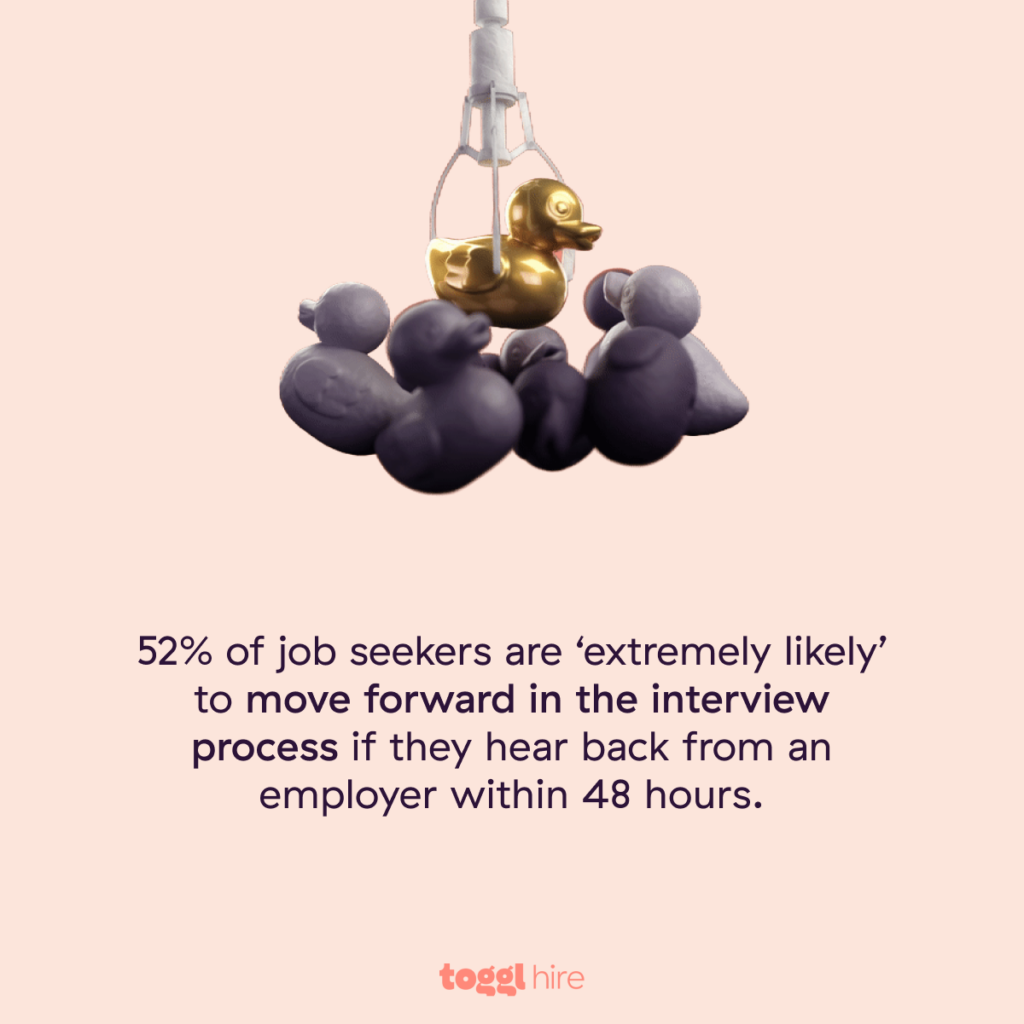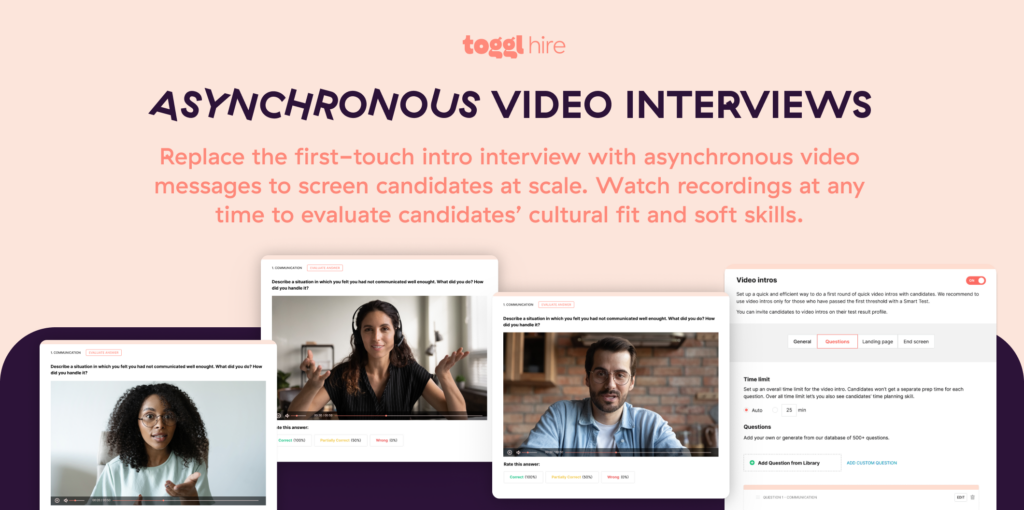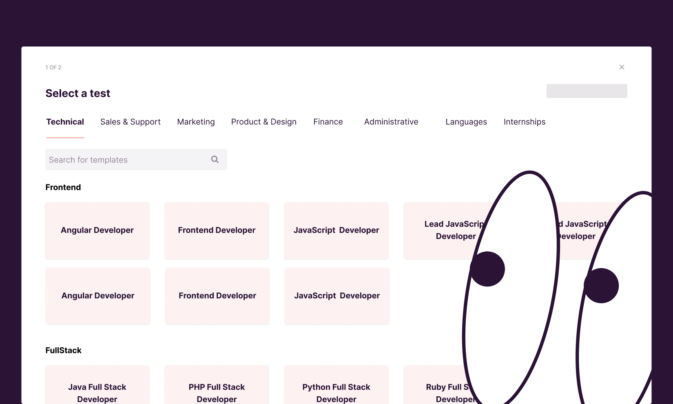The interview process is all about getting to know a potential candidate — learning what they’re capable of and who they are. When recruiters have the chance to do this in person, they can connect with candidates, build trust, and hook someone who’s a good fit. However, in-person interviews aren’t always possible (or even the best option) in today’s digital world.
Since the workforce of today operates differently — with digital nomads and more remote workers and teams than ever before — video has become a fundamental communication channel for many companies.
But even with video calls being the new norm, how can you recreate an interview environment where candidates can be themselves and feel confident enough to open up to you?
In this article, we’ll:
- Discuss the advantages and disadvantages of virtual interviews
- Share 10 tips that can help you conduct virtual interviews with ease
🚀🚀🚀
The rise of virtual interviews

According to a recent Indeed survey, 88% of employers have conducted video or virtual interviews. And this figure is not surprising if we consider how the world of work has changed over the last decade. And the radical shift due to the pandemic.
The necessity for digital communication, like our reliance on videoconferencing software, pushed technological advances and also forced companies to rethink their standard hiring process.
The pros and cons of conducting virtual interviews
Virtual interviewing, like many other interviewing methods, has its pros and cons for both the interviewer and interviewee. Since there’s a lot at stake for both parties, it’s good to consider all eventualities, like if someone’s dog barks during the video interview or other unplanned interruptions.
The benefits of virtual interviews
Conducting virtual interviews can save money, streamline the hiring process, and provide you with more control over the candidate experience.
1. Save money
In business, it’s all about the bottom line, so let’s start there. Virtual interviews are way more cost-effective than trying to meet every qualified candidate for an in-person interview.
When the average cost to hire is estimated to be around $4,700, according to the Society for Human Resource Management, any dollars you can knock off of that amount can reduce hiring costs (and boost your hiring team’s Key Performance Indicators!).
2. Increased convenience
Convenience is another checkmark in the “pro” column — an added convenience for the candidate and the interviewer.
With an in-person interview, it’s possible that one of the parties can no longer make a scheduled interview time. That means the hassle of rescheduling and finding that elusive slot when the interviewee can make it to your office, and the interviewer is free again.
37% of job seekers say they feel less intimidated during remote interviews, and 31% are no longer anxious about arriving late.
Indeed Survey
Luckily, with a virtual interview, both parties can join from anywhere on the globe (or, who knows, even from Mars one day!).
3. A shorter time to hire
Virtual interviews help to streamline the entire hiring process. They’re a great pre-screening tool. Plus, you can squeeze in many more virtual interviews into a week than in-person interviews, with all their obligatory to-and-fro.
4. Better candidate experience
Virtual interviews also add more control to the hiring process. And that’s a plus for the candidate and employer. You empower potential employees, and they could become one of your business’s biggest fans — creating a positive wave throughout the talent pool!

5. Reduce bias
When you meet a potential candidate in person, you may also open the door to interviewer bias. These conscious (or unconscious) conclusions you reach about the candidate are not based on their skills or aptitude.
However, virtual interviews help prevent this, at least in small ways. Videoconferencing technology does create a feeling of distance from the other person (also the reason why creating rapport is vital with virtual interviews).
The drawbacks of virtual interviews
Nowadays, it feels like we can solve every business problem with technology, so it’s hard to imagine that using video conferencing software would have any downside. But as we know, neither technology (nor those that use it) are infallible.
1. Technical difficulties
Job interviews are stressful enough for everyone involved. The last thing you want is a bunch of glitches that make the process even more complicated.
With virtual interviews, you could run into a number of technical issues — from connectivity problems to lagging audio to the video function not working. These can easily increase everyone’s stress levels.
2. Less personal
Another potential drawback is that interacting via video doesn’t feel as personal as sitting and chatting to someone in person over a cup of coffee.
You don’t have the opportunity to pick up on any other nonverbal cues that might be happening outside of the video frame like you would in person.
33% of job seekers feel they cannot clearly convey their personalities as well in a virtual interview as they can in person.
Indeed Survey
Today, video calls and virtual interviews have become commonplace, and though it will never give you the same connection as face-to-face, our ability to read people via a digital screen is likely improving (and it’s still way better than phone screening).
3. Nervous candidates
Alright, so candidates are probably going to be nervous whether an interview is happening via phone, video, or in person. The hiring process itself can be nerve-wracking for a lot of people.
But, the element of being “on camera” may introduce additional anxiety for people. Candidates might not present themselves as well on video as they would if you met in person. The interviewer can help by ensuring that, from their end, it’s a distraction-free zone.
10 tips for developing a winning virtual interview process
Okay, so let’s see how you can set up virtual interviews that are a win-win for all and speed up match-making the right candidate with the right job.
1. Outline the hiring process in the job description
Clearly set out the steps of your company’s hiring process so the candidate knows what to expect.
Try introducing skills assessments to the process to streamline it beyond virtual interviews. Hire faster with Toggl Hire’s ready-made role-specific test templates!
2. Share key information ahead of the interview
Let the candidate know as much ahead of time as possible, such as logistics (time and video software details), who will be in the interview, and the agenda. You can also share interview prep tips like finding a quiet place for the interview and having a glass of water at hand.
Perhaps even create a standard virtual interview guide that you share with candidates. The guide can walk them through how to prepare for their interview and outline everything that they need to do ahead of time. Not only will you help to calm their nerves, but also ensure a more productive (not to mention less distracting) interview.
3. Build rapport at the start of the interview
To spark an instant connection with the candidate, try icebreaker questions like:
- What’s your favorite place in the world and why?
- What’s your favorite emoji?
- What are your favorite pizza toppings?
- What do your family and friends think you do all day?
- What’s one sentence you’d like to hear from your boss?
If the candidate applied via a skills test, share positive feedback – they made it to the interview because they obviously have enough knowledge and experience about the role. If they applied via CV, share feedback on anything that caught your attention in their application.
4. Recap on the virtual interview agenda
Chat through what you’ll be covering during the interview. And reassure the candidate that they’ll have time to ask their questions, too (since the interview process really goes both ways!).
5. Kick off with your intro, including info on your company culture
It can be helpful to share your company values, like teamwork, and how those translate into your organizational culture, such as how teams collaborate well with each other to achieve more.
Something beneficial to include is info on your diversity and inclusion policy as well as your company’s approach to employee health and wellbeing.
6. Have a list of questions ready and follow a structured process
A structured interview means sticking to a specific set of questions that are prepared in advance and remain the same for every candidate. Structured interview questions help to keep the hiring process fair and ensure you’re comparing apples with apples with each candidate.
Learn how you can help prospective employees provide detailed answers using the STAR Interview method. 👇
7. Remember your body language
These interviews may be happening virtually, but it is still a job interview — which means you need to look and behave professionally. Sit up straight. Make eye contact by looking directly at your camera. Don’t get distracted by emails or social media notifications.
Always remember the person on the other side of the screen can still see you, which means your body language does matter. Plus, candidates will likely follow whatever example you set. So, the more professional you are, the more professional they’ll be.
8. Discuss essentials like salary, working hours, and benefits
Get into the nitty gritty, like working hours, more about your remote work policy, and the benefits they’ll receive, like an annual study allowance, for instance.
9. Leave time for candidate questions
Leave enough time for the candidate to ask their questions, and let them essentially interview you too. It’s important they learn what they want to know about the role, the company culture or anything else that’s important to them.
10. Share the next steps
Let them know exactly what’ll happen next in the hiring process and when, so they’re not left wondering whether they’ll ever hear from you again. (Hey, nobody likes being ghosted!)

11. (BONUS) Give pre-recorded video interviews a try
Bonus track! You could also give pre-recorded video interviews a shot as a way to modernize and automate your talent screening process.
Pre-recorded video interviews are a form of structured virtual interviews where both the employer and the candidate communicate via asynchronous video messages. For the hiring manager, this is a neat optimization strategy for gaining back time (record it once, distribute it to all candidates) and an effective way to pre-qualify candidates for face-to-face virtual interviews.

Nail your next video interview
Video interviews can have a big impact on the overall candidate experience. To ensure you knock their socks off, nail your virtual interview process and get ’em hooked on your organization from that first video call.
Also, remember that a structured interview process is a good way to source higher-quality candidates and a smoother hiring regime.
Ready to give async video interviews a try? Click here to see how they work at Toggl Hire!

Juste loves investigating through writing. A copywriter by trade, she spent the last ten years in startups, telling stories and building marketing teams. She works at Toggl Hire and writes about how businesses can recruit really great people.




